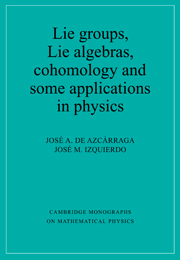Book contents
- Frontmatter
- Contents
- Preface
- 1 Lie groups, fibre bundles and Cartan calculus
- 2 Connections and characteristic classes
- 3 A first look at cohomology of groups and related topics
- 4 An introduction to abstract group extension theory
- 5 Cohomology groups of a group G and extensions by an abelian kernel
- 6 Cohomology of Lie algebras
- 7 Group extensions by non-abelian kernels
- 8 Cohomology and Wess-Zumino terms: an introduction
- 9 Infinite-dimensional Lie groups and algebras
- 10 Gauge anomalies
- List of symbols
- References
- Index
1 - Lie groups, fibre bundles and Cartan calculus
Published online by Cambridge University Press: 08 February 2010
- Frontmatter
- Contents
- Preface
- 1 Lie groups, fibre bundles and Cartan calculus
- 2 Connections and characteristic classes
- 3 A first look at cohomology of groups and related topics
- 4 An introduction to abstract group extension theory
- 5 Cohomology groups of a group G and extensions by an abelian kernel
- 6 Cohomology of Lie algebras
- 7 Group extensions by non-abelian kernels
- 8 Cohomology and Wess-Zumino terms: an introduction
- 9 Infinite-dimensional Lie groups and algebras
- 10 Gauge anomalies
- List of symbols
- References
- Index
Summary
‘It is vain to do with more what can be done with fewer’ (≈ entities should not be multiplied without necessity)
William of Ockham (c.1285–1349)This chapter contains some topics of differential geometry which are needed for the rest of the book. They have been selected to serve as a reference for readers already familiar with them or as a self-contained introduction for those who encounter them for the first time.
The central concepts of Lie group, Lie algebra and their relations are analysed. This involves the introduction of left and right-invariant vector fields and forms, which in turn motivates the study of various concepts of differential geometry, such as differential forms, differential operators and de Rham cohomology. In particular, the Maurer-Cartan equations will be extensively used in the text due to their relation with Lie algebra cohomology. A review on fibre bundles is also provided due to their importance in the problem of extensions and in the study of Yang-Mills theories which will be treated in later chapters.
A few comments on how to extend some of the above Lie group concepts to graded Lie groups are made by taking the supertranslation group as an example. This requires a small knowledge of supersymmetry; those not interested in ‘super’ objects may skip it since it is possible to read the book omitting the few sections that contain topics related with supersymmetry. The last two sections (Appendices) contain information and tables on the homotopy groups and the Poincare polynomials of the simple Lie groups and on the homotopy groups of spheres.
- Type
- Chapter
- Information
- Publisher: Cambridge University PressPrint publication year: 1995

